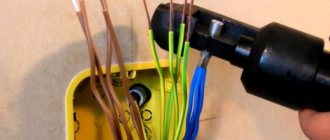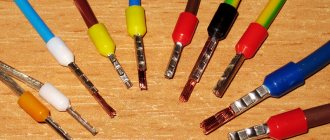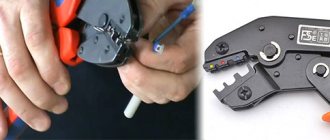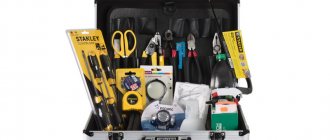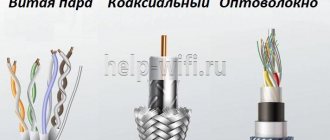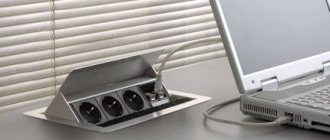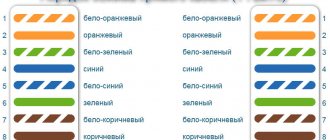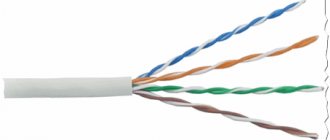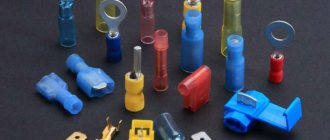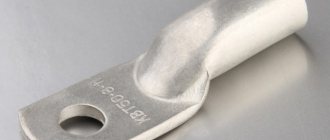Crimping technology
There are two methods by which crimping is carried out:
- local indentation;
- complete compression.
The wire for crimping is copper or aluminum. Therefore, the sleeve can be either copper or aluminum. There is also copper-aluminium. Since an aluminum cable is prone to the formation of an oxidizing film, the aluminum sleeve must be cleanable and treated with a special lubricant. To protect aluminum from oxides, quartz vaseline paste is used. Copper wire is also subject to lubricant treatment. With its help, the likelihood of damage to the core during crimping is reduced and friction is reduced.
If the cores are multi-wire, they are aligned and folded so that they easily fit into the sleeve; you can twist the wires a little. Then the cable is inserted into the cartridge until it stops. The connection can be made not end-to-end, but, for example, with a factory. Then the total cross-section of all wires should not exceed the cross-section of the bushing.
In any case, sleeves are used that are designed for the total cross-section of the cores being crimped. If a press with point (local) indentation is used, make 2-3 pressings evenly distributed along the length of the sleeve to ensure mechanical strength of the connection and good electrical contact. For continuous crimping using hexagonal or square dies, the recommendations are essentially the same
In both cases, it is important that the sleeve does not crack during crimping (if it is too small) and that there are no uncompressed areas or cavities (if it is too large)
After the crimping has been carried out, it is necessary to create an outer insulating layer at the junction using electrical tape or elbow cloth. After insulation, you should carefully fold the wires and the cable itself in the junction box.
The video below clearly shows how to crimp wires with press pliers:
Dies for press jaws
Why do we need as many as 5 sets of matrices? There is not only a difference in the cross-section of the crimped tips, but also in their functionality and standard size.
You can choose your ideal option for each type of tip. In CTB press tongs, as in CTF, the dies are interchangeable, which makes these sets absolutely compatible and can significantly save your budget.
Most often it is necessary to use dies designed for crimping insulated and non-insulated bushings of the NShVI and NShV brands. The matrix is digitally marked along the cross section of the tip.
These dies are specially designed to form a monolithic pin at the end of a stranded strand.
To impart mechanical strength, special corrugation is applied to the inner surface of the crimp profile.
The matrix of the MPK-02 model fits the most popular range of sleeve tips with a cross-section from 0.25 to 6mm2.
What to do if you have a sleeve tip with a cross-section of as much as 25mm2? Here the matrix of the MPK-03 model will help you out. This matrix already crimps insulated and non-insulated sleeve lugs from 10 to 25mm2.
To crimp double sleeve tips of the NShVI-2 brand, you need to use the MPK-06 matrix. It has 7 positions and crimps tips from 0.5 to 6mm2.
Keep in mind that it is not included with the tool and you will have to purchase it separately. You can view current prices and choose matrix sets for yourself here.
There is another way out of the situation. If you need to crimp a double tip NSHVI-2, but it is not possible to purchase an additional matrix for it, use the ordinary MPK-02 matrix.
The only condition is that you need to crimp such an NShVI-2 with a connector one size larger.
That is, when you have a double tip with a cross-section of 4mm2 NShVI(2)-4-12, then you need to press it with a matrix designed for a single one under 6mm2.
The set also includes an MPK-01 matrix for insulated connectors of the NKI, NVI brands and the like. It is designed for sections from 0.5 to 6mm2.
Well, the last two sets of matrices are MPK-04 - for auto terminals and MPK-05 - for non-insulated copper lugs.
The matrices are inserted into the pliers in such a way that the side of the matrix with the smallest cross-section of the crimping profile is always located at the edge of the jaws.
This crimper compresses the NSHVI sleeve tips with a trapezoid. This crimp profile is quite wide and can cause some problems with connecting individual equipment. Keep in mind that when connecting wires to starters of the second magnitude, after crimping the wires of relatively large cross-sections with a trapezoid, sometimes you have to insert them into the contacts sideways.
How to connect electrical wires with lugs
Another way is to use tips. The tip looks like a piece of tube, cut and turned flat on one side. A hole for a bolt is drilled in the flat part. The lugs allow you to connect cables of any diameter in any combination. If it is necessary to connect a copper cable to an aluminum cable, special lugs are used, in which one part is copper and the other is aluminum. It is also possible to place a washer, brass or tinned copper, between the tips.
The ferrule is pressed onto the cable using a crimper, similar to how wires are connected using crimping.
How to brew twist
For good contact, the twist can be welded with a graphite electrode or a gas torch. Torch welding has not become widespread due to the complexity and the need to use gas and oxygen cylinders, so this article only talks about electric welding.
Electric welding is performed using a graphite or carbon electrode. Graphite electrode is preferable. It is cheaper and provides better welding quality. Instead of a purchased electrode, you can use a rod from a battery or a brush from an electric motor. It is better not to use copper electrodes. They often get stuck.
For welding, you first need to make a twist 100 mm long, so that the finished one turns out to be about 50. The protruding wires need to be trimmed. For welding, it is best to use an inverter welding machine with adjustable current. If this is not the case, then you can take a regular transformer with a power of at least 600 W and a voltage of 12–24 V.
Near the insulation, “ground” or “minus” is connected using a thick copper clamp. If you simply wrap a wire around a twist, the twist will overheat and melt the insulation.
Before starting welding, it is necessary to select the current. The required current varies depending on the number and thickness of the wire that makes up the twist. The welding duration should be no more than 2 seconds. If necessary, welding can be repeated. If everything was done correctly, then a neat ball will appear at the end of the twist, soldered to all the wires.
Application area
Press tongs KVT
Pliers for crimping wire lugs of certain designs are used depending on the cross-sectional composition of the cable product. The main areas of use of crimpers can be represented by the following list:
- stranded wires and thin-walled lugs;
- stranded wires and thick-walled lugs;
- lugs and large-section electrical cable;
- sequential crimping of wires;
- crimping computer cables.
Stranded wires and thin-walled ferrules
Thin-walled lugs are used for small-section wires - from 0.5 to 3.5 mm2. The elements are marked NSHVI. The abbreviation stands for as follows:
- N – tip;
- Ш – pin;
- B – bushing;
- And - isolated.
NSHVI lugs are used for crimping stranded copper wires with subsequent insertion into sockets of various electronic devices. The crimper handles are compressed until the spring mechanism of the device is activated.
NShVI tips
Note! Multi-stage clamp matrices allow you to work simultaneously with wires with a cross-section in the range indicated above. This eliminates the need for a large number of hand crimping tools.
Press pliers create a strong and reliable compression of the tips. Without them, one would have to twist stranded cores or solder the terminals of switchgear devices. The use of pressed end switches completely eliminates problems associated with breakage of thin wires, wire breakage, and the risk of short circuit.
Stranded wires and thick-walled ferrules
Thick-walled shanks are used for crimping multi-core power cables. Their maximum cross-section reaches 16 mm2. Press pliers PK-16 are used only for multi-core wires. The tool can compress the sleeve so tightly that it can easily break a single core.
The cable crimping process occurs in several stages:
- At the end of the wire, mark the length of the sleeve.
- Using special nippers, remove the insulation from the marked area.
- Place a piece of heat-shrinkable tubing so that it does not touch the exposed wire.
- The cleaned end of the cable is inserted into the sleeve. The insertion of the wire should be tight, but without force.
- The tip is crimped using pliers.
- The protruding veins are bitten off.
- Use a hair dryer to heat the heat shrink tube until it tightly grips the cable.
Pliers PK-16-U
If the letter “U” is indicated in the marking of the tool, this means that the ratchet mechanism is located inside the handles, which creates a large force on the jaws of the crimper. The PK-16-U pliers compress more easily during cable crimping.
Large cross-section lugs and electrical cable
Crimping for large cross-section electrical cable lugs is done using a manual hydraulic press. Initially, the valve of the device is slightly open, and the rod slowly moves to its original position. At the beginning of the piston stroke, the valve opens completely, which ensures compression of the dies with great force.
Large cross-section cables are rarely found in indoor equipment. Hydraulic pliers are mainly used for installing lugs on high-voltage cables for fastening them in switchboards of industrial facilities. Hydraulic crimping pliers for dimensional lugs are also used for laying and switching power cables in power panels at the entrances of residential buildings, administrative buildings and civil buildings.
The hydraulic press is equipped with cassettes with replaceable dies. The upper lever is equipped with a magnet, which, after compression, returns the handle to its original position. The levers are equipped with rubberized shells, which ensure electrical safety of the device. Crimping of two cables with a double-sided sleeve is carried out when moving the electrical panel. These pliers for simultaneous crimping of two wires are also used when extending copper conductors with a diameter of 6-12 mm2.
Hydraulic Press
Consistent wire crimping
This method is used when connecting sections of wires into a single whole. This is especially important for sequential crimping of conductors with cores made of different metals. For example, when you need to make a connection between aluminum and copper wires, use a crimp sleeve.
The fact is that twisting metals of different names will cause destructive processes from their direct contact with each other. The connecting sleeve becomes a kind of bridge between aluminum and copper.
The bare wires are inserted into the sleeve on both sides. After this, the sleeve is compressed with pliers. The compressed sleeve prevents air from entering the connection, which prevents the occurrence of oxidation processes in the metal of the wires.
Computer cable crimping
Often the question arises of crimping an Internet cable to connect it to a computer or connecting several PCs with a local network. For this purpose, a twisted pair cable is used. The wires are unraveled and distributed parallel to each other. At the same time, the strict color arrangement of the wires is observed.
Plastic RJ-45 connectors are used as tips. Polymer tips are intended for insertion into the sockets of hubs and network adapters. A twisted pair consists of eight wires. Insulated conductors twisted in pairs minimize interference when electric currents pass through them.
Plastic cable lug
Special crimpers are used to crimp cable ends. The RJ-45 connector is a plastic box with an opening for the cable on one side and contact terminals on the other side.
Power cable crimping pliers
The process of installing connectors on network cables is as follows:
- remove one centimeter of insulation, for this there is a special connector on the pliers;
- twisted pairs are unraveled and aligned in a certain order;
- Using wire cutters, cut the wires evenly so that the bare ends of the cores are formed;
- the wires are inserted into the RJ-45 connector, the cut wires with their cores should be tightly adjacent to the back of the terminals;
- The plastic connector is inserted into the opening of the pliers, then the tool handles are squeezed.
The twisted pair wires should be arranged from left to right in the following order (looked from above from the entrance to the connector):
- White-orange.
- Orange.
- Green-white.
- Blue.
- Blue and white.
- Green.
- White-brown.
- Brown.
Tip sizes, design features
The minimum available sections for GML are 1.5 mm 2. Further sizes increase - 2, 4, 6, 10 mm 2 and higher. Based on these values, we can say that the cross-sections of the sleeves are equal to those of wires and cables. It is quite easy to decipher the tip designations. For example, GML-6 is a copper tip, tinned. The cross-section is 6 mm 2. In the case of combined sleeves, the marking indicates two sizes - for aluminum wire and for copper. For example, GAM 16/10 - 16 for aluminum, and 10 for copper.
By design, the sleeves can be end-to-end in the form of a hollow tube or with a partition. The latter are used when crimping wires with end-to-end lugs is performed. These partitions are located in the middle of the sleeve. With their help you can adjust the depth of the cable entry. If it is necessary to extend it, then both ends will go into the tip to the same length.
Features of crimping pliers
The principle of operation of the tool is similar to the operation of pliers. The difference between crimping pliers for ferrules is the complex profile of the pressing jaws. Crimping pliers or crimpers have different sizes and shapes of the planting bed. Each type of tool is designed for crimping wires and cables with a certain cross-section and number of cores.
Tools for crimping wire lugs and cable cores allow you to quickly and efficiently make switching connections between power units. The crimping process for cable lugs is quite simple. A sleeve is placed on the bare end of the wire or stranded wire. She is led into the opening of the ticks. Using the force of the fingers, the hands squeeze the levers of the tool, and the crimper compresses the sleeve with the wire.
Principle of wire crimping
You can perform crimping of wires using sleeves in several ways. It will not be possible to single out the best of them, since comparison is inappropriate here. The choice of crimping method directly depends on the conditions for electrical installation work, cross-sectional parameters and other important points. Let's consider the features of the main method of crimping using sleeves.
Work begins by introducing the previously stripped ends of the wires into the cavity of the sleeve. The next step is crimping - squeezing using a special tool. The metal surface of the cores and sleeve is compressed, resulting in a reliable adhesion of the parts. It is necessary to connect at several points, followed by insulation of the connection points. An exception is working with insulated sleeves for crimping, which do not require additional insulation.
When choosing this method of connecting wires, you need to remember that the contact will not be disconnected in the future. Taking this into account, work will need to be carried out carefully and prudently.
The main points of the process of crimping wires and twists
To do this, you will need to strip the wire from the outer insulation, and then use a mounting knife to remove the inner protective sheath. To make it convenient to twist the wires, I personally collect the bare wires into a bundle and bend the ends.
Then, first twisting the wires by hand, I achieve greater contact through the work of the pliers with which I tighten the twist.
Having bitten off the excess wires with the same tool, I get a good connection 3-5 cm long.
Next, the only thing left to do is put copper sleeves of suitable sizes on the twists and crimp them. Moreover, crimps come in different diameters (6 mm, 8 mm, 10 mm and more). Usually, I use 6 mm products to connect strands of light groups, where the cross-section of the wires is not so large (1.5 sq. mm). For socket groups, sleeves with a diameter of 8 mm or more are taken, since here the wires have a cross-section from 2.5 to 4 sq. mm.
After that, I insulate the connections, put them in the junction box and close the lid so that everything is “feng shui”.
Selecting a tool for crimping power lugs and sleeves
The entire “KVT” tool for crimping power lugs and sleeves can be divided into 3 main groups according to the principle of operation:
- Mechanics,
- hydraulics,
- battery tool.
Depending on the shape of the crimping profile, wedge-shaped and hexagonal crimping are also distinguished.
The principle of wedge-shaped crimping (indentation) is most often implemented in mechanical press jaws. In addition to hand tools for crimping lugs on small-section wires (from 1.5 mm2 to 10 mm2 or maximum 35 mm2), wedge-shaped crimping is in demand when installing cables and wires with solid-drawn monocores. Wedge crimping is considered a reliable alternative to soldering, but, like soldering, it is gradually falling out of use. However, this method has its advantage - most often such presses are equipped with a built-in punch and one matrix, so that when using them, constant changes of dies are not required and they can crimp tips of any standard, not exceeding the capabilities of the tool.
Hexagonal (hexagonal) crimping is by far the most popular and popular technique for installing cable sleeves and lugs. Hexagonal crimping has a number of advantages:
- The hexagonal profile of the matrices ensures uniform compression of the lug shank onto the cable core along the entire perimeter. Due to this, the maximum contact connection area and a high degree of sealing are achieved.
- Due to the uniform compression of the walls of the tip shank, the likelihood of the formation of microcracks and defective fractures of the tip material is reduced.
- There is no possibility of pinching and damage to the current-carrying core of the cable. Gentle crimping and integrity of the cable core are of particular importance when crimping stranded cores of 2-6 flexibility classes
- With the correct selection of matrices, the hexagonal crimping method provides a much stronger mechanical connection between the tip and the conductor, and also guarantees reliable electrical contact.
According to the operating principle of the KVT press, they are divided into:
- mechanical (PC, PMU, PKG and PMo series),
- hydraulic (PGR, PGRs, PG and PGP series)
- and battery (PGRA).
In terms of productivity, mechanical presses are inferior to hydraulic and battery-powered tools. However, mechanical tools have their advantages:
- They are not sensitive to the temperature at which installation takes place, have a reliable design and do not require special maintenance.
- When working with tips of small sections (from 1.5 to 10 mm2), it is more convenient and faster to work with a hand-held, compact mechanical tool. However, we should not forget that crimping with mechanical presses occurs solely due to the physical strength of the operator, which makes them uncompetitive when carrying out a large volume of work that requires a significant number of crimps.
- Lack of replaceable dies and removable parts.
The popularity of hydraulic tools is due to the high pressing force from 5 to 100 tons, relatively low price and high operational reliability. Hydraulic tools "KVT" can be divided into 4 main groups:
— manual hydraulic presses of the PGR models of the “Master” series without an ASD valve,
— manual hydraulic presses of the PGRs models of the “Profi” series with an ASD valve,
— manual hydraulic presses of the PGRs models of the “Profi” series with an ASD valve and
automatic return of the rod,
— pump-action hydraulic heads of PG models with a remote pump.
Advantages of KVT hydraulic presses:
- All KVT hydraulic manual presses, except the 70th series, are equipped with a two-stage mechanism for accelerated pressure build-up, which reduces the number of “idle strokes” before closing the dies and significantly saves installation time.
- Presses of the professional PGRs series are equipped with an ASD (automatic pressure release) valve - when the maximum operating pressure is reached, the valve is activated, preventing further pressure from being pumped into the working cavity of the tool. This solution significantly increases the working life of the tool and protects it from possible breakdowns.
- In accordance with ergonomic requirements, a number of models or elements of KVT hydraulic presses are made of high-strength aluminum alloy, which significantly reduces their weight.
- The widest range of crimping: copper and aluminum tips with a cross-section from 4 to 1000 mm2
- For models of the 300th series of KVT presses, the assortment includes sets of precision dies for crimping tips and sleeves of the most popular standards in Russia (GOST, KVT standard, DIN, etc.)
- All hydraulic presses have a rotating head, which makes work easier and increases productivity
crimping tool The only thing that limits its widespread use today is the relatively high price due to the cost of the motor with an electronic control board and batteries.
At the same time, the cordless tool has almost all the advantages of classical hydraulics, which is not surprising, since it uses the same principle of pressurization, plus it has its own “tricks”:
- High speed.
- Complete absence of physical effort during operation - just press a button.
- All models of KVT battery presses are equipped with an ASD system and an advanced automatic rod return mechanism, which guarantees a full crimping cycle and tool integrity.
Table for crimping power lugs using mechanical press jaws and hydraulic presses KVT
Common mistakes when crimping
Cutting shells
At first glance, they are long. People who do not have the necessary knowledge and experience believe that using the entire cartridge case is wasteful, and cut it into pieces. This leads to a reduction in the length of the section where the conductors are bonded. The result is that the mechanical strength of the contact suffers, since working with pliers becomes inconvenient, and the number of pressure points decreases.
Wrong choice of sleeve diameter
If it is larger than required, then it is unlikely that it will be possible to produce high-quality crimping. The only way out is to bend the tip of the wire and then insert it into the sleeve. But such crimping is only suitable for “copper”, but the strength of the connection becomes lower. Aluminum wire breaks easily, so it is not an option.
With a smaller sleeve diameter, people without experience try to “plant” the ends of the wires into it by sharpening them a little. This is absolutely forbidden to do! Reducing the cross-section in a particular area leads to overheating and destruction of the metal. By the way, this often causes inflammation. It remains to add that the contact strength also decreases.
Crimping with pliers
Press jaws are specially designed for this specific job. Crimping with pliers is fraught with the fact that the conductor is deformed, and quite significant. After all, with this connection method it is impossible to control the clamping force. The consequences of reducing the cross-section of the core are indicated above.
Some craftsmen do crimping exactly this way, while assuring that everything is “acceptable.” But this does not mean that this technique is correct. The author came across such a situation and asked the unfortunate master a question: if he needs to do crimping at home, will he also work with pliers? As expected, there was no clear answer.
Useful tips
- It is not always possible to select a sleeve so that after placing the ends of the conductors in it, there are no voids left. The more free space, the higher the risk of poor contact after crimping it. How to proceed? The easiest way out of the situation is to cut pieces of wire (bare) with a length slightly shorter than that of the sleeve, and “hammer” them into it. Such artificial compaction will significantly improve the quality of crimping.
- If the connection of wires is made to extend the line, then their joint should be located in the center of the sleeve.
- When insulating the joint, the tape (tube) must extend beyond the sleeve cuts by at least 10 mm.
- In the case when at least one of the wires is multi-core, or different numbers of them are spliced on both sides, not metal sleeves are used for crimping, but insulated lugs (NSHVI).
It turns out that there is nothing complicated about crimping with sleeves. The main thing is to choose the right size. If the reader takes into account the recommendations given, then it is quite possible to cope with such work on your own. Good luck!
Connection Features
The technology involves two options for crimping. This is a method of local indentation and continuous compression. Copper or aluminum wires are used for work. The sleeve must also be made of these materials. There are also elements made of copper-aluminum alloy.
Since aluminum cables are prone to the appearance of oxidative films on them, the sleeve must first be cleaned and treated with special lubricants. Copper wires are also pre-treated. The use of lubricants in the process reduces the risk of possible damage to the cores. The friction force is also noticeably reduced. Pressure testing is carried out using manual or hydraulic tools. In the latter case - with a figure press. It is usually used in large industries.
How it works? The two ends of the cable are crimped until they take a round shape. Next, the core is inserted into the sleeve until it stops. It is possible to connect not exactly end-to-end. But in this case, the cross-section of all cores does not exceed the bushing. In the case of local compression, contact directly depends on the depth of the pits. The latter can be measured with a caliper. If continuous compression is used, then check the cross-sectional area. Then, when the crimping of the wires is completed successfully, it is necessary to treat the outer layer with electrical tape or elbow cloth. Next, the wire and cable are carefully laid in the junction box.
Types of connecting tubes
Crimping of wires can be carried out using connecting sleeves in several designs. The choice of connecting tube will depend on the electrochemical properties of the metal from which it is made and its interaction with the material of the wire.
There are several options for materials for the manufacture of sleeves:
- copper;
- tinned;
- combined universal;
- isolated.
Copper tubes (CM) are used for copper wires, the crimping of which cannot damage the protective layer due to its absence. The tubes cannot be used in aggressive environments.
Tinned sleeves (GML) are suitable for copper type cables used in aggressive conditions. The white protective layer covering the surface of the product fully copes with the main functions. The tubes are not suitable for working with aluminum wires due to possible contact of the protective layer, which is partially destroyed during compression, with aluminum.
Combined wire sleeves have a distinctive feature - their shape. The aluminum part is larger than the copper part. This is due to the resistance of aluminum, which exceeds the resistance of copper. During the crimping process using such tubes, wires are inserted on each side, taking into account the type of metal.
The last option for sleeves is insulated (GSI). They replace additional insulation with PVC tapes due to the presence of heat-shrinkable tubing. Their structure is similar to the structure of GML tubes, with the exception of a PVC layer that does not transmit electricity. The protective layer is quite plastic and reliable, indestructible even during the crimping process, taking the shape of a metal.
Differences in wire crimping tubes by material
Connecting sleeves are divided into several types depending on the material of manufacture. The use of different types is due to the fact that, due to the electrochemical properties of metals, some react actively with each other, which leads to oxidation of the wires and their overheating under load.
Copper sleeves
The abbreviation GM indicates that the sleeve is made of high-quality copper. Used exclusively for connecting copper wiring. The surface of the GM is not covered with a protective shell, so it can only be used in non-aggressive environmental conditions.
Tinned sleeves
Tinned sleeves are used to connect copper wires intended for use in aggressive environments. These are the same copper sleeves, only their surface is coated with a special compound that forms a white protective shell. The abbreviation is as follows - GML.
The advantage of tinning is to protect the material from electrochemical corrosion, however, it is prohibited to use GML for aluminum wiring. This is due to the fact that during the compression process the protective layer is partially destroyed, which will result in direct contact between aluminum and copper.
Connecting tubes for cores made of different materials
The installation of electrical lines, as a rule, is not complete without the use and connection of cores made of different materials. For such purposes, special sleeves are used, which are considered combined and are called GAM. The design is simple, but its peculiarity lies in the use of different materials. Two parts of the tube are welded into one, one is made of aluminum and the other of copper. The middle, the junction is equipped with a special limiter. Thanks to it, equal input of the cores is ensured on both sides.
This variety differs in shape. This can be explained by the fact that the aluminum part of the tube has a larger diameter due to the need for a larger cross-section of the conductor.
The algorithm for crimping GAM is similar to the previous methods.
There is another type of sleeves designed for crimping wires. Its difference lies in the coating of the surface with insulation. Their operation does not require the additional use of connecting heat-shrinkable tubes or PVC tape. The surface of the sleeves is covered with a material that has plastic characteristics. During crimping, the PVC layer is also compressed, but there will be no direct contact between the sleeve and the wire.
What is the essence of the method?
Crimping is a method of connecting wires using special sleeves. Outwardly, they look like ordinary tubes and serve as a connecting mechanism.
The wire strands that are to be connected are inserted into the tube from two opposite ends, crimped with press pliers, and as a result, a strong and reliable electrical unit is obtained. The tube is compressed in two or three places, depending on its length and the cross-section of the switched conductors. The connected cores and the sleeve are jointly subjected to deformation. At this moment, the tube compresses and squeezes the conductive surfaces of the conductors. Due to this, the wires interlock with each other, which provides reliable electrical contact.
The junction is then isolated.
Most often, this method is used in situations where it is not possible to use another type of connection. For example, welding requires the presence of electricity so that the welding machine can be connected. When working in a small junction box, it is inconvenient to position the bolt connection, nut clamp or terminal block. And reaching up to the distribution box from the ceiling with a soldering iron is also not very convenient. It is in such cases that crimping wires using sleeves helps out.
The crimping method is most in demand:
- if it is necessary to connect wires in power lines with a high current load;
- for switching multi-core conductors;
- if it is necessary to connect large cross-section wires.
This is interesting: How to choose a cable channel for electrical wiring: let's look carefully
What is crimping wires with sleeves?
Crimping with sleeves is a permanent connection of wires.
Crimping is a common procedure in electrics, its peculiarity lies in the connection of electrical wiring with special sleeves. The connecting mechanism is a connecting tube made of metal. To crimp the wires, their cores are inserted into a sleeve. By crimping the tube with the wires inside, it is possible to achieve a reliable connection. At home, crimping is done using pliers, but it is preferable to use a special tool - press pliers.
The sleeve is compressed in two or three places, and the pressed area is insulated using insulating PVC tape or heat shrink tubing. Sometimes insulated connecting sleeves are used to connect elements; in this case, there is no need to re-process the electrical wiring section.
Connecting wires with sleeves must be carried out in the following cases:
- It is necessary to connect wires with a large cross-sectional area.
- There is no possibility of using alternative methods of connecting the wire. For example, wiring inside a distribution box where visibility is poor at high altitudes or where it is impossible to place the terminal block.
- It is necessary to connect wires in lines with high load.
Crimping sleeves for wires have their advantages and disadvantages. The first ones predominate:
- The crimping tool is equipped with a comfortable working area. This principle of operation allows you to perform assigned tasks in a limited space, for example, in distribution boxes or a socket box. Inside the socket box, crimping the wiring contacts allows you to shorten the wires to an absolute minimum.
- To compress the tube used, crimping pliers are used. Unlike analogues, this tool does not require a connection to electricity to operate and belongs to the group of manual ones. If the power is not yet connected, crimping is the only reliable way to connect the wires.
- To carry out soldering or welding, you must have certain knowledge and skills. Any person can cope with crimping after the first trial time. It is important to have press pliers and consumables; in extreme cases, you must have pliers.
Crimping allows you to connect wires made of different materials, for example, aluminum and copper. Soldering and welding do not provide such opportunities.
The disadvantages include the following:
- The need to constantly have in stock and regularly replenish stocks of cartridges of different sizes.
- The connection is characterized by considerable dimensions, which sometimes complicates the implementation of certain tasks.
It is also worth mentioning the significant costs of consumables.
Twist connection
The easiest way to connect wires is twisting. Previously, this was the most common method, especially when wiring in a residential building. Now, according to the PUE, connecting wires in this way is prohibited. The twist must be soldered, welded or crimped. However, these methods of connecting wires begin with twisting.
In order to perform high-quality twisting, the connected wires must be cleared of insulation to the required length. It ranges from 5 mm when connecting wires for headphones to 50 mm if it is necessary to connect wires with a cross-section of 2.5 mm². Thicker wires are usually not twisted together due to their high rigidity.
The wires are stripped with a sharp knife, insulation stripping pliers (ISR) or, after heating with a soldering iron or lighter, the insulation is easily removed with pliers or side cutters. For better contact, bare areas are cleaned with sandpaper. If the twist is supposed to be soldered, then it is better to tin the wires. Wires are tinned only with rosin and similar fluxes. This cannot be done with acid - it corrodes the wire and it begins to break at the soldering site. Even washing the soldering area in a soda solution doesn’t help. Acid vapors penetrate under the insulation and destroy the metal.
The stripped ends are folded parallel into one bundle. The ends are aligned together, the isolated part is held firmly with your hand, and the entire bundle is twisted with pliers. After this, the twist is soldered or welded.
If there is a need to connect the wires to increase the total length, then they are folded opposite each other. The cleaned areas are placed crosswise on top of each other, twisted together by hand and tightened tightly with two pliers.
You can only twist wire made of the same metal (copper with copper, and aluminum with aluminum) and of the same cross-section. Twisting wires of different sections will turn out uneven and will not provide good contact and mechanical strength. Even if it is soldered or crimped, these types of wire connections will not ensure good contact.
How to use crimping pliers correctly
Twisted Pair Crimping Tool: Crimping Tool
Self-mastery of crimping pliers may initially be accompanied by the creation of a poor-quality connection between the sleeve or tip and the wire. It often happens that what appears to be a reliably performed crimp hides a bad contact. This can happen for two reasons.
If the shape of the terminals is not maintained
A discrepancy between the size of the tip or sleeve and the opening between the matrix jaws can cause distortion of the compressed element. Before you start crimping, you should try on the tip to the opening in the pliers. It is also important that the bare end of the wire fits tightly into the holes of the shank or sleeve.
A bundle of wires or a single core should fit into the connecting element with light tension. If you have any doubts about the reliability of the fastening, you should practice on separate sections of the cable. After crimping by hand, you need to check the strength of the connection. If there is the slightest play, the crimp should be rejected and crimping should be resumed with a different end cap.
Excessive clamping may damage the conductors inside the sleeve. The accompanying documentation for crimping pliers usually indicates the cross-sectional dimensions of the tips directly for each opening of the pliers. The use of connectors made of soft metal alloys should be avoided. Over time, the tip may lose strength and contact will become unreliable.
Twisting stranded wires before crimping
A mistake can be made due to the habit of twisting the wires, which is done before insulating or soldering manual connections. This is absolutely impossible to do.
You can check the harmfulness of twisting in a simple way. It is worth squeezing the twisted multi-core cables with pliers to make sure that there is deformation and damage to the integrity of the wiring.
If, when removing insulation from the cable installation section, twisted conductors are found, they must be straightened. Only after this the conductors are inserted into the opening of the tip or sleeve.
Standard crimping errors
There are several typical mistakes that novice electricians or those who carry out the core crimping process themselves make. For example:
- The used sleeve has a cross-section smaller than the wire. There is never any need to reduce the cross-section of the cores and adjust it to the diameter of the sleeve. This leads to an increase in resistance and a decrease in throughput. Where there was a combination, the vein will heat up and collapse.
- Large size sleeve. If the socket is used with a large diameter, it will not bring a strong and reliable connection. Even if you bend the wire several times, this will not lead to good performance, since the mechanical strength will drop by almost half.
- Cutting the sleeve into several parts. When crimping a cable with a short length of exposed ends, it is inconvenient to work with pliers, and the contact area is reduced.
- Crimping should be carried out exclusively using press jaws. Special tools were invented for this joining method. Therefore, you should not use pliers or a hammer, as this can damage both the sleeve and the cable. To prevent this from happening, it is necessary to use a tool such as press pliers, as they greatly simplify the work of crimping cable connections.
That's all I wanted to tell you about how wires are crimped with sleeves. We hope the information provided was useful and interesting for you!
You probably don't know:
- Methods for connecting LED strip
- Which electrical tape is best for electrical wiring?
- How to find a junction box in a wall
Wire crimping: common mistakes
Many novice electricians or people who do not have information in the field of electrical installation often make a number of mistakes that affect the subsequent operation of the entire electrical circuit.
Pressure testing can be carried out using sleeves or tips
Installation errors:
- The sleeve cross-section is smaller than the cable cross-section;
- Sleeve of larger cross-section;
- Saving;
- Crimping without using pliers.
When purchasing crimps (sleeves), many do not take into account such an important factor as the cable cross-section. Therefore, after purchasing a crimp sleeve or sleeves, it turns out that its cross-section is smaller than the cross-section of the wire.
The main mistake that is made in this case is reducing the cross-sectional area of the cable, which is completely unacceptable. This is due to the fact that at the junction of the wires, resistance increases, which leads to heating of the wires during operation. And if a device with higher power is connected to this network, the wire may simply burn out and lead to a short circuit.
The use of sleeves with a large cross-section will not allow achieving high-quality and reliable contact
It is important to understand that with this connection, the mechanical strength also decreases
In order to save on connecting elements, many divide one sleeve into several parts, thereby increasing the resistance accordingly.
The rules stipulate that crimping of sleeves must be done only with a special tool in the form of press pliers. Therefore, a hammer or pliers are completely unsuitable for this job.
This is due to the fact that using a hammer can damage the sleeve, and compressing the sleeve with pliers is not enough for good contact.
Why do you need crimping and crimping wires?
Is it even possible to do without sleeves and crimping? What's wrong with simply attaching wires to machines and other devices?
With a simple clamp, the bundle of wire fluffs up and is crushed to the sides. Some individual conductors may even be damaged. Such conductors, destroyed and separated from the main bundle, no longer take part in contact and the passage of current load through themselves.
All this leads to the fact that the remaining cores are not enough and the connection points heat up. In addition, the bare copper from which the wire strands are made remains accessible to moisture and oxygen. And this leads to its darkening and oxidation. By crimping the conductor once with a tip or sleeve, you will save yourself from all these problems in the future.
Classification by material of manufacture
One of the main parameters, depending on which wire sleeves are divided into different types, is the material of their manufacture. The need to use dissimilar sleeves is determined by differences in the electrochemical properties of the connected wires made of different metals. So, if an inappropriate sleeve is chosen to connect wires made of a certain metal, the place of the formed contact will oxidize, which over time will lead to a decrease in its reliability in terms of electrical conductivity.
The main types of sleeves for crimping electrical wires, depending on the material from which such tubes are made, are:
- copper sleeves;
- tinned connecting sleeves;
- combined;
- isolated.
Copper
A copper sleeve, which is marked GM, is needed for crimping wires also made of copper. Taking into account the fact that the copper sleeve does not have a protective coating, it can only be used to connect wires operated in a non-aggressive environment. If you neglect this requirement, the copper sleeve will quickly oxidize and cease to perform its functions.
Copper cable sleeves must be made from copper tubes of grades M1 or M2
Tinned
To connect electrical wires operated in an aggressive environment, tinned copper sleeves for crimping are used, which are marked GML. In order to protect the main material of their manufacture - copper - from electrochemical corrosion, GML sleeves are coated with a special compound.
This is explained by the fact that part of the protective coating of such a tube is destroyed when it is compressed, which will lead to contact between aluminum and copper and, accordingly, to the development of electrochemical corrosion.
Connecting sleeves type GML, made of electrical copper with a tin-bismuth protective coating
Combined
Quite often, when installing electrical networks, it becomes necessary to connect wires whose cores are made of different metals. To solve such problems, combined type sleeves have been specially developed and are successfully used. The design feature of such crimp tubes, which are marked GAM, is that one half of them is an aluminum connecting sleeve, and the second is made of copper. At the junction of two such tubes, which are connected to each other by welding, there is a special limiter. It is necessary in order to prevent contact of two dissimilar wires inside the sleeve itself.
Adapter cable sleeve aluminum-copper 16/10 sq. mm
Another design feature of combined crimp tubes is that the part of them, which is the aluminum connecting sleeve, has a larger diameter than the tube intended for copper cables. This design feature is explained by the fact that aluminum, when compared with copper, has greater electrical resistance, therefore the wire made from it, which will be connected to the same electrical network with a copper conductor, must have a larger diameter.
The crimping itself using combined sleeve clamps is performed according to the same algorithm as the procedure with sleeves of any other type. However, it is necessary to carefully ensure that dissimilar wires are inserted into a tube of the appropriate metal.
Isolated
Among the crimping tubes used for crimping electrical wires, the category of insulated connecting sleeves is distinguished. The use of the latter eliminates the need to perform additional insulation of the contact area formed with their help. In terms of their design, insulated sleeves are the same tinned copper tubes, the outer surface of which is covered with an insulating layer of fairly durable and at the same time plastic PVC. Due to the mechanical properties of such a protective layer, sleeves of this type can be successfully crimped without compromising their original characteristics.
Fully insulated connection sleeves
Insulated sleeves for hermetically sealed connection of SIP wire cores
Types of lugs for crimping stranded wires
The above article contains a lot of information about the tool used to perform crimping. But for the quality of the connection, it is equally important to choose the right tip. There are also several types of them. Let's focus on products for multi-core wires.
Related article:
Wire stripping tool: variety of accessories
Characteristics, scope of use. Types of devices. Types of strippers. Popular models from famous brands.
Copper tips. Externally, they look like a copper tube, flattened on one side, in which there is a hole for a bolt. Such tips are divided into uncoated (TM) and tinned (TML) elements. The latter are used in cases where it is necessary to make a connection with high anti-corrosion properties. Crimping of wires with lugs of this type can be carried out by any type of pliers, the matrix of which corresponds to the cross-sectional dimensions.
Copper with inspection hole. This option cannot be crimped; soldering is used for connection. The information is provided for general information. Externally, the tips are similar to the previous ones, differing only in the presence of a hole through which the position of the conductors can be seen.
Insulated lugs are suitable for stranded wires; non-insulated lugs are suitable for solid wires.
Aluminum. Aluminum wires are crimped with lugs made of the same material. Externally, they are absolutely similar to copper ones and are marked MA.
Important! Before crimping, aluminum conductors must be treated with quartz-vaseline paste. It prevents the appearance of an oxide film.
Press pliers for crimping tips of this type can be used either hydraulic or manual.
Pin. They are used to make permanent connections. They are designated by the abbreviation NSHVI - insulated pin sleeve end. The wires, stripped of insulation, are inserted into a sleeve and crimped using pliers.
Copper lugs with inspection holes cannot be crimped
Wire lug for crimping: ring, hook, fork
To connect to the terminal blocks, you need to use lugs that will ensure the most reliable connection. The main condition is that they must match the type of this terminal block. Today there are three main types of such tips:
- Ring. Their purpose is to connect to screw terminal blocks. Providing a large contact surface is one of the advantages of this type of tip. A similar option is used for temporary and permanent connections in low-voltage networks.
- Hook type tips. They create a contact surface a quarter smaller than ring ones. To crimp an electrical cable with lugs of this type and connect it to a terminal, you do not need to completely unscrew the fixing screw. Such lugs are more often used for temporary connections or in situations where it is impossible to unscrew the screw for some reason.
- Fork. These tips have a contact surface that is 50% smaller than ring tips. It is for this reason that they are more often used for temporary connections when constant change of contacts is required.
There are other types of tips, but they are specific and are used quite rarely, mainly by professional electricians when installing complex circuits.
Using press pliers, you can crimp various types of lugs: ring, fork, pin
Domestic tool: wire lug crimping pliers KVT
Among the domestically produced tools, the press pliers for crimping KVT wire lugs deserve attention. The main enterprise is located in Kaluga. Particularly popular are CTF kits, which include matrices for crimping insulated and non-insulated tips, and CTF kits, which include number matrices.
The STV set consists of the following subject units:
- press jaws;
- 5 numbered matrices;
- plastic case.
The pliers are equipped with a mechanism for quickly replacing matrices. High-quality steel is used as the material for the manufacture of the tool. The design of the press has a lever for unlocking. If the matrix size is incorrectly selected, the crimping process may not be completed, as a result of which the handles will be blocked in an intermediate position. In such cases, the tool returns to its starting point using a lever.
It is worth noting that the handles of the pliers are elongated, which allows crimping to be done with two hands. Five matrices make it possible to select the option needed for a specific type of tip.
Press pliers for crimping KVT wire lugs are a fairly popular tool.
The CTF set also has 5 matrices. Pressing pliers for tips are not equipped with a device for quickly changing them, so a hex key must be used. The process of replacing the matrix takes quite a long time, sometimes even longer than the crimping itself. The STF kit (unlike STV) contains two additional screws for the matrices in case the used one is lost or damaged.
Important! When inserting the matrices, in order not to make a mistake, you need to pay attention to the size of the slot: the large one goes towards the handles, the smaller one - towards the head of the pliers.
How to connect electrical wires by soldering
Connecting electrical wires by soldering is very reliable. You can solder untwisted wires, but such soldering will be fragile due to the fact that the solder is a very soft metal. In addition, it is very difficult to lay two conductors parallel to each other, especially when suspended. And if you solder on some kind of base, the rosin will stick the soldering area to it.
A layer of rosin is applied to the pre-tinned and twisted conductors with a soldering iron. If another flux is used, it is applied in the appropriate manner. The power of the soldering iron is selected based on the cross-section of the wire - from 15 W when soldering headphones to 100 W when soldering twisted wires with a cross-section of 2.5 mm². After applying the flux, tin is applied to the twist with a soldering iron and heated until the solder completely melts and flows into the twist.
After the soldering has cooled, it is insulated with electrical tape or a piece of heat-shrinkable tubing is put on it and heated with a hairdryer, lighter or soldering iron.
When using a lighter or soldering iron, be careful not to overheat the heat shrink.
This method reliably connects wires, but is only suitable for thin wires, no more than 0.5 mm², or flexible ones up to 2.5 mm².
Terminal block connection
A development of the bolted connection is the terminal connection. Terminal blocks come in two types - with a rectangular pressure washer and with a round one. When using a terminal block with a pressure washer, the insulation is removed to a length equal to half the width of the terminal block. The bolt is released, the wire is slipped under the washer and the bolt is clamped again. On one side, you can connect only two wires, preferably of the same cross-section and only flexible or only single-core.
Connecting to a terminal block with a round washer is no different from using a bolted connection.
The connection of the wires is reliable, but cumbersome. When connecting wires with a cross-section of more than 16 mm², the connection is unreliable or the use of lugs is necessary.
How to connect wires by crimping
Another way to connect wires is crimping. This is a method in which a copper or aluminum sleeve is placed on the wires or cables to be connected, and then crimped with a special crimper. For thin sleeves, a manual crimper is used, and for thick ones, a hydraulic one is used. This method can even connect copper and aluminum wires, which is unacceptable with a bolted connection.
To connect using this method, the cable is stripped to a length greater than the length of the sleeve, so that after putting on the sleeve, the wire sticks out 10–15 mm. If thin conductors are connected by crimping, then twisting can be done first. If the cable has a large cross-section, then, on the contrary, in the stripped areas it is necessary to align the wire, fold all the cables together and give them a round shape. Depending on local conditions, the cables can be folded with the ends in one direction or in the opposite direction. This does not affect the reliability of the connection.
A sleeve is tightly placed on the prepared cables or, when laid in opposite directions, the wires are inserted into the sleeve from both sides. If there is still free space in the sleeve, it is filled with pieces of copper or aluminum wire. And if the cables do not fit in the sleeve, then a few wires (5–7%) can be cut off with side cutters. If you do not have a sleeve of the required size, you can take a cable lug by sawing off a flat part from it.
The sleeve is pressed 2–3 times along its length. The crimping points should not be located at the edges of the sleeve. It is necessary to retreat 7–10 mm from them so as not to crush the wire during crimping.
The advantage of this method is that it allows you to connect wires of different sections and from different materials, which is difficult with other connection methods.
How to choose the right wire and tip
First, you need to find out what cross-section of wire you will be crimping. This can be done by following the inscriptions on the core insulation, or using a caliper. Further, when choosing certain sleeve tips, you can be guided by the color marking of their insulated skirt. Each color must correspond to a specific section and size of the tip sleeve.
True, there are also manufacturers who don’t bother with this and produce single-color products of different sections. After choosing, be sure to physically check how tightly the wire fits into the sleeve or tip. In this case, there is absolutely no need to twist the wires before inserting them into the tip.
The tip at the entrance has a special skirt that will help you put it on even a slightly fluffy wire. In addition, this skirt acts as an insulation retainer. You can compare how many kinks in different directions the wire will withstand and without a skirt. As you understand, the result will not be in favor of the latter option.
Another important point that needs to be remembered: many wires are manufactured not according to GOST, but according to their own technical conditions.
And therefore, their actual cross-section may be less than that stated in the nomenclature. Accordingly, because of this, a slack is formed in the pressed part of the tip, although as it seemed to you, you selected everything according to the tables and seemed to have made no mistakes anywhere.
It often happens that a 2.5mm2 wire easily fits into a tip with a cross-section of 1.5mm2. Therefore, choosing from tables is, of course, good, but you can’t do without practical fitting of the sleeved part and wire.
